Abstract
One paradox of voting states that, in a general election, in which many citizens vote, the probability that a single voter can affect the outcome is so small that in general citizens have no rational reason for voting. However, if all citizens accept this reasoning, then none will vote, and so each vote has a large probability of affecting the outcome. Hence all should vote after all. The adoption of mixed strategies resolves this paradox: if each citizen adopts a certain (small) probability of voting, then the actual number of citizens voting will be just enough to make it worth those citizens' while to vote. A Nash equilibrium point thus occurs. Here we compute Nash equilibria for the simple case of majority voting; for the more complicated case of composite voting (for example, as in a presidential election), we draw certain qualitative inferences.
Similar content being viewed by others
References
Aranson, P.H. (1971). Political participation in alternative election systems. Presented at the Annual Meeting of the American Political Science Association, Chicago, September 7–11, 1971.
Banzhaf, J. III. (1965). Weighted voting doesn't work: A mathematical analysis. Rutgers Law Review 19: 317–343.
Beck, N. (1975). A note on the probability of a tied election. Public Choice 23(Fall): 75–80.
Chamberlain, G., and Rothschild, M. (1981). A note on the probability of casting a decisive vote. Journal of Economic Theory 25 (August): 152–162.
Coleman, J. (1971). Control of collectivities and the power of a collectivity to act. In B. Lieberman (Ed.), Social choice. New York: Simon and Schuster.
Downs, (1957). An economic theory of democracy. New York: Harper and Row.
Erickson, R. (1979). Why do people vote? Because they are registered. Presented at the Conference on Voter Turnout, San Diego, May 16–19.
Feller, W. (1957). An introduction to probability theory and its application, I. New York: Wiley.
Ferejohn, J., and Fiorina, M. (1974). The paradox of not voting: A decision theoretic analysis. American Political Science Review 68(June): 525–536.
Ferejohn, J., and Fiorina, M. (1975). Closeness counts only in horseshoes and dancing. American Political Science Review 49(Sept.): 920–925.
Finkelstein, M.O. (1978). Quantitative methods in law. New York: Free Press.
Good, I.J., and Mayer, L.S. (1975). Estimating the efficacy of a vote. Behavioral Science 20:25–33.
Grofman, B. (1981). Fair apportionment and the Banzhaf Index. American Mathematics Monthly 88(−): 1–5.
Grofman, B., and Scarrow, H. (1981). Riddle of apportionment: Equality of what? National Civic Review 70, 5(May): 242–254.
Hinich, M.J. (1981). Voting as an act of contribution. Public Choice 36: 135–140.
Linehan, W.J., and Schrodt, P.A. (1979). Size, competitiveness and the probability of influencing an election. Presented at the Conference on Voter Turnout, San Diego, May 16–19.
Lucas, W.F. (1974). Measuring power in weighted voting systems. Case Studies in Applied Mathematics. Mathematics Association of America, Module in Applied Mathematics, 1976. (Originally published as Technical Report No. 227, Department of Operations Research, College of Engineering, Cornell University, Ithaca, N.Y, September.)
Margolis, H. (1977). Probability of a tied election. Public Choice 31(Fall): 135–138.
McKelvey, R.D., and Ordeshook, P.C. (1972). A general theory of the calculus of voting. In J.F. Herndon and J.L. Bernd (Eds.), Mathematical applications in political science, Vol. 6, Charlottesville, Va.: University press of Virginia.
Meehl, P.E. (1977). The selfish citizen paradox and the throw away vote argument. American Political Science Review 71(March): 11–30.
Niemi, R.G. (1976). Costs of voting and nonvoting. Public Choice 27(Fall): 115–119.
Owen, G. (1979). Multilinear extensions and the Banzhaf value. Naval Research Logistics Quarterly 22, 4(Dec.): 741–750.
Riker, W.H., and Ordeshook, P.C. (1974). An introduction to positive political theory. Englewood Cliffs, N.J.: Prentice-Hall.
Riker, W.H., and Ordeshook, P.C. (1968). A theory of the calculus of voting. American Political Science Review 62 (March): 25–43.
Wuffle, A. (1979). Should you brush your teeth on November 4, 1980? Paper not prepared for delivery at the Conference on Voter Turnout, San Diego, May 16–19, 1979.
Author information
Authors and Affiliations
Additional information
This research was supported by NSF Grant # SES 80-07915, Program in Political Science. We thank the members of the staff of the Word Processing Center, School of Social Sciences, University of California, Irvine, for their invaluable assistance in typing repeated drafts of this manuscript; we also thank Linton Freeman, Dean of the School of Social Sciences, and Charles Lave, Chair of the Program in Economics and Public Choice, for facilitating a visiting appointment for Professor Owen at the University of California, Irvine, to permit the authors to pursue their collaborative research. The junior author also thanks the students in his course ‘Introduction to Decision Analysis, ’whose questions about rational choice models of citizen turnout prompted the writing of this essay.
Rights and permissions
About this article
Cite this article
Owen, G., Grofman, B. To vote or not to vote: The paradox of nonvoting. Public Choice 42, 311–325 (1984). https://doi.org/10.1007/BF00124949
Issue Date:
DOI: https://doi.org/10.1007/BF00124949




